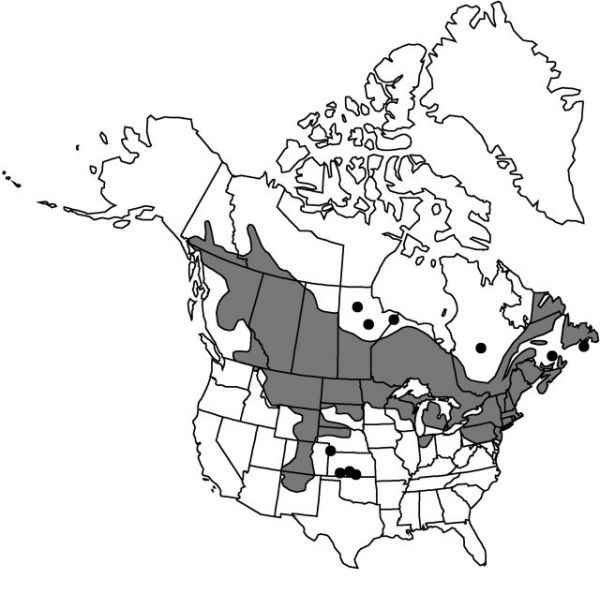Difference between revisions of "Sisyrinchium montanum"
Pittonia 4: 33. 1899.
FNA>Volume Importer |
imported>Volume Importer |
||
| (6 intermediate revisions by 2 users not shown) | |||
| Line 8: | Line 8: | ||
}} | }} | ||
|common_names=Bermudienne montagnarde | |common_names=Bermudienne montagnarde | ||
| + | |special_status={{Treatment/ID/Special_status | ||
| + | |code=W1 | ||
| + | |label= | ||
| + | }}{{Treatment/ID/Special_status | ||
| + | |code=F | ||
| + | |label=Illustrated | ||
| + | }}{{Treatment/ID/Special_status | ||
| + | |code=E | ||
| + | |label=Endemic | ||
| + | }} | ||
|basionyms= | |basionyms= | ||
|synonyms= | |synonyms= | ||
| Line 22: | Line 32: | ||
|distribution=North America. | |distribution=North America. | ||
|discussion=<p>Varieties 2 (2 in the flora).</p><!-- | |discussion=<p>Varieties 2 (2 in the flora).</p><!-- | ||
| − | --><p>Eastern coastal populations of Sisyrinchium montanum appear to have some slight affinity to S. angustifolium (e.g., long connation of outer spathe) and some previous floras have combined the two taxa. Some taxonomists have questioned the recognition of varieties within S. montanum, but we feel that the differences between them are no more subtle than those between varieties generally recognized elsewhere in the genus. Living material was not available to us to investigate breeding barriers. Although Sisyrinchium montanum is considered weedy by D. T. Patterson et al. (1989), I have seen many populations all through the western states and Great Lakes areas and would not consider it weedy in any of these portions of the range.</p> | + | --><p>Eastern coastal populations of <i>Sisyrinchium montanum</i> appear to have some slight affinity to <i>S. angustifolium</i> (e.g., long connation of outer spathe) and some previous floras have combined the two taxa. Some taxonomists have questioned the recognition of varieties within <i>S. montanum</i>, but we feel that the differences between them are no more subtle than those between varieties generally recognized elsewhere in the genus. Living material was not available to us to investigate breeding barriers. Although <i>Sisyrinchium montanum</i> is considered weedy by D. T. Patterson et al. (1989), I have seen many populations all through the western states and Great Lakes areas and would not consider it weedy in any of these portions of the range.</p> |
|tables= | |tables= | ||
|references= | |references= | ||
| Line 45: | Line 55: | ||
-->{{#Taxon: | -->{{#Taxon: | ||
name=Sisyrinchium montanum | name=Sisyrinchium montanum | ||
| − | |||
|authority=Greene | |authority=Greene | ||
|rank=species | |rank=species | ||
| Line 56: | Line 65: | ||
|publication title=Pittonia | |publication title=Pittonia | ||
|publication year=1899 | |publication year=1899 | ||
| − | |special status= | + | |special status=W1;Illustrated;Endemic |
| − | |source xml=https:// | + | |source xml=https://bitbucket.org/aafc-mbb/fna-data-curation/src/2e0870ddd59836b60bcf96646a41e87ea5a5943a/coarse_grained_fna_xml/V26/V26_744.xml |
|genus=Sisyrinchium | |genus=Sisyrinchium | ||
|species=Sisyrinchium montanum | |species=Sisyrinchium montanum | ||
Latest revision as of 22:16, 5 November 2020
Herbs, perennial, cespitose, pale to olive green or dark brown to bronze when dry, to 5 dm, not glaucous; rhizomes scarcely discernable. Stems simple, obviously winged, (1.5–)2–3.7 mm wide, glabrous, margins entire (in eastern populations) to denticulate (in western populations) apically, similar in color and texture to stem body. Leaf blades glabrous, bases not persistent in fibrous tufts. Inflorescences borne singly; spathes usually green or bronze, rarely with purplish margins, glabrous, keels usually denticulate; outer 36–76 mm, 12–46 mm longer than inner, slightly constricted proximal to apex, margins basally connate 2–5.7 mm; inner with keel ± gibbous basally, sinuous proximally, hyaline margins 0.1–0.3 mm wide, apex acuminate to acute, ending 0.9–4.3 mm proximal to recurved green apex. Flowers: tepals dark bluish violet, bases yellow; outer tepals 9–14.5 mm, apex emarginate to retuse, aristate; filaments connate ± entirely, stipitate-glandular basally; ovary similar in color to foliage. Capsules tan to dark brown, sometimes with purplish tinge apically, ± globose to obovoid, 4–6.8 mm; pedicel erect to spreading. Seeds globose to obconic, lacking obvious depression, 0.9–1.5 mm, rugulose.
Distribution

North America.
Discussion
Varieties 2 (2 in the flora).
Eastern coastal populations of Sisyrinchium montanum appear to have some slight affinity to S. angustifolium (e.g., long connation of outer spathe) and some previous floras have combined the two taxa. Some taxonomists have questioned the recognition of varieties within S. montanum, but we feel that the differences between them are no more subtle than those between varieties generally recognized elsewhere in the genus. Living material was not available to us to investigate breeding barriers. Although Sisyrinchium montanum is considered weedy by D. T. Patterson et al. (1989), I have seen many populations all through the western states and Great Lakes areas and would not consider it weedy in any of these portions of the range.
Selected References
None.
Key
| 1 | Margins of outer spathe connate basally 4–5.7 mm; plants drying dark brown or bronze. | Sisyrinchium montanum var. crebrum |
| 1 | Margins of outer spathe connate basally 1–3.5 mm; plants drying green to olive. | Sisyrinchium montanum var. montanum |